|
International Perspectives - November 8, 1999
Anne D. Picker
International Economist, Econoday
Action at last
Interest rates are on the move - up...
Both the Bank of England and the European Central Bank raised interest rates Thursday as expected. The Bank of England's basic lending rate edged up 25 basis points to 5.5 percent while the ECB's lending rate jumped 50 basis points to three percent. This is the second 25 basis point increase by the Bank of England since September, when the rate also was raised by 25 basis points. This is the first rate increase by the ECB since it began formal operations at the turn of the year. European stock markets responded favorably to the news. The Royal Bank of Australia also raised their base lending rate 25 basis points to five percent earlier in the week. It was the first rate increase in five years. Now the countdown to the U.S. Federal Reserve Open Market Committee meeting on November 16th begins in earnest.
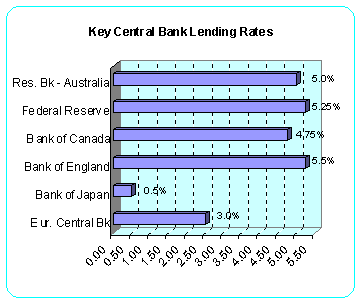
Bank of England
The Bank of England Monetary Policy Committee's decision to raise their policy making repurchase rate proves the central bank is "ahead of the curve". But analysts think that it will not be enough to prevent further increases as inflationary pressures in the economy intensify. As expected, the MPC increased their repo rate 25 basis points to 5.5 percent. Hardly anyone had been expecting anything else. The Bank did not offer any explanation.

European Central Bank
The European Central Bank raised its main refinancing rate by 50 basis points to three percent effective with the refinancing auction on November 10th. The 50 basis point increase was at the high end of expectations and suggests the ECB wanted to end rate speculation for some time to come. The ECB also raised its deposit rate, which forms the floor for money market rates, by 50 basis points to two percent, while the marginal lending rate, which forms the ceiling, was increased by 50 basis points to four percent.
Swiss National Bank
The Swiss National Bank left its benchmark discount rate unchanged at a record low of 0.5 percent, asserting its autonomy after the European Central Bank raised its interest rates. The SNB's decision not to follow the ECB comes after Swiss central bank officials repeatedly said they see no need to shadow the European Central Bank's policy at all times. In April, however, they reduced their discount rate by 50 basis points immediately after the ECB announced its 50 basis point rate cut.
Reserve Bank of Australia
The Reserve Bank of Australia's policy setting board approved its first interest rate increase in five years, raising the target rate on overnight bank loans to five percent. The bank last raised rates in December 1994 by 100 basis points. This latest move reversed a 25 basis point cut made 11 months ago, because the economy is growing faster than expected.
Indicator scoreboard...
The first week of the month brings with it an onslaught of purchasing managers surveys and sentiment surveys in Europe. Last week was no exception. To sum up, the outlook is good. Below are summaries on a country by country basis. A key to understanding these surveys is that a level above 50 indicates expansion, while a level below 50 indicates contraction. The overall and manufacturing indexes were above 50 and climbing. However, so were the price subindexes.
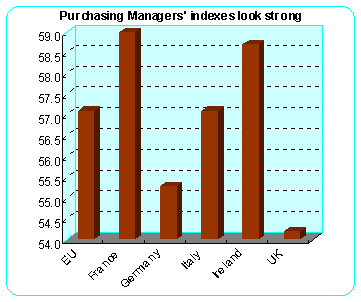
European Monetary Union
October's manufacturing activity survey expanded for the seventh month in a row, according to the Reuters Purchasing Managers' Index. The PMI is based on data from five countries (Germany, France, Italy, Spain and Ireland), rose to 57.1 from 54.7 in September, and was above all forecasts. The prices index rose to 69.4 from 63.2.
Italy
In October, the PMI manufacturing sector expanded for the fourth month in a row, with the seasonally adjusted ADACI/Reuters purchasing managers' index rising strongly to 57.13 from 53.62 in September. But prices increased for the fourth month in a row, and at a much faster pace in October than in September. The seasonally adjusted prices index surged to 71.07 from 61.65.
France
October manufacturing expanded for the ninth month in succession as the seasonally adjusted CDAF/Reuters Purchasing Managers Index rose to 59.0 from 57.3 in September. The seasonally adjusted price index reached its highest level since the survey began in November 1997 at 75.5 after 69.1 in September. Improved global demand for manufactured goods in a phase of depleted inventories is boosting production.
Germany
The purchasing managers index rose again in October, showing the German manufacturing sector expanded for the fourth month in succession, according to the BME/Reuters Purchasing Manager's Index. The seasonally adjusted index rose to 55.3 from 53.7 in September. The prices index climbed to 64.4 - the highest level since the launch of the index in April 1996 - from 60.2 in September. Since April 1998, the price index had been below 50 - indicating overall falling prices.
Britain
Several surveys were released last week. Briefly, construction industry activity once again showed strong growth in October, although the rate of expansion slowed further versus the previous month, according to a survey published jointly by the Chartered Institute of Purchasing and Supply and NTC Research. The latest improvement was mainly attributed to a general expansion of demand and better business conditions. Input prices continued to rise sharply but at the same rate as in September, with the index unchanged at 59.5.
Service sector growth eased in October but inflation gathered pace, according to figures published by the Chartered Institute of Purchasing and Supply. The CIPS Report on Services business activity index fell back to 55.7 in October - the lowest level since March this year - from an unrevised 57.1 a month earlier. Inflationary pressures grew strongly, with the prices charged index showing the first expansion for four months. The index rose above the critical 50 mark to 51.7 in October from 49.0 in September.
October manufacturing sector activity accelerated for the second month in a row, according to the Chartered Institute of Purchasing and Supply. The purchasing manager's index increased to 54.2 from 54.1 in September. The survey showed average input prices rose at the fastest rate in four years, with the index rising to 56.2 from 54.4 in September.
Other Indicators...
EMU
Second quarter GDP growth was unrevised from previous estimates, rising 0.5 percent on the quarter and 1.6 percent when compared with a year earlier. However, some of the GDP components were revised. Household consumption on a quarter-over-quarter basis was revised downward but was almost exactly offset by an upward revision in inventory change and net exports.
Britain
House prices soared ahead in October, with the monthly increase the highest since mid-1988 and the annual change in double digits for the first time since August 1989. The Halifax house price index jumped 2.8 percent on the month in October and 10.8 percent on the year. The monthly change was last higher in September 1988 when it was 3.6 percent while the annual rate was the fastest since August 1989 when it stood at 14.2 percent. The data may exaggerate the underlying strength of the market and October's climb should be viewed alongside the more subdued September figures. The Bank of England watches housing prices closely as part of their policy making process.
The recovery in the manufacturing sector continued in September, with output rising 0.2 percent on the month and 0.5 percent on the year. July and August data were also revised much higher. However, total industrial output fell 0.2 percent on the month but rose 0.8 percent on the year.
Germany
September seasonally adjusted manufacturing orders dropped 4.5 percent on the month after a downwardly revised 5.4 percent increase in August. The drop was bigger than expected, although the orders uptrend remains intact. In the third quarter, manufacturing orders rose 4.9 percent, up from a gain of 3.1 percent in the second quarter.
Italy
September preliminary producer prices, up 0.7 percent on the month and 0.8 percent year-on-year driven higher by a surge of intermediate prices due primarily to higher electricity and petroleum prices. Producer prices when compared with last year were positive for the first time since July 1998.
August unadjusted industrial orders rose 2.4 percent when compared with last year boosted by a 7.5 percent rise in domestic demand, which offset a fall of three percent in foreign demand. Domestic orders were the highest since March 1998. However, in the eight months to August orders fell 1.9 percent versus the same period last year. Unadjusted turnover in August rose 9.3 percent on the year.
Asia
Australia
Australia recorded a 1.24 billion Australian dollars (US$1 billion) seasonally adjusted deficit on international trade of goods and services in September, up from A$1.3 billion in August, and above the previous record gap of A$1.78 billion in April. An unexpected seven percent increase in imports was driven by a 23 percent rise in the capital goods sector, thanks to imports of civil and defense aircraft. Economists focused on export performance, which points to both improved economic growth and a reduction in the current account deficit in coming quarters.
Americas
Canada
Employment grew strongly in October for the second consecutive month. The increase of 80,000 jobs builds on September's gain of 64,000 and brings job gains so far this year to 253,000 (+1.7 percent). The unemployment rate dropped 0.3 percentage points to 7.2 percent, its lowest level since March 1990. Nearly all of the employment gains in October were in the goods producing sector (+74,000). Growth was particularly strong in manufacturing (+55,000), continuing the upward trend that began in the industry a year ago. Over the last 12 months, manufacturing employment has increased by 205,000 jobs.
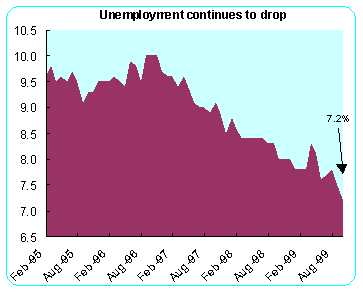
World Financial Markets
World equity markets
The markets were relieved that both the Bank of England and the European Central Banks increased their base interest rates and the uncertainty was gone. Overseas markets reacted favorably to the rate increases. On Friday, the European markets rebounded from declines early in the day and reversed direction on the benign employment situation report in the United States. The markets' fluctuations on a day to day basis were not as volatile as they had been in the prior weeks.
The focus this coming week will be on the U.S. Federal Reserve meeting on November 16th At stake is whether the U.S. Federal Reserve Open Market Committee will decide to raise interest rates also. There are few market moving indicators this week to distract the markets from that meeting.
| Selected World Stock Market Indexes |
| Index | 5-Nov | 1999
High | 1999
Low | Week %
Change |
|---|
| Asia |
| Australia | All Ordinaries | 2919.80 | 3145.20 | 2804.80 | 1.20 |
| Japan | Nikkei 225 | 18354.90 | 18357.90 | 13232.70 | 2.30 |
| Hong Kong | Hang Seng | 13610.27 | 14506.74 | 9076.33 | 2.67 |
| S. Korea | Korea Composite | 913.09 | 1027.93 | 498.42 | 9.55 |
| Singapore | Straits Times | 2111.55 | 2222.45 | 1286.56 | 3.15 |
| Europe |
| Britain | FTSE 100 | 6356.60 | 6420.60 | 5770.20 | 1.61 |
| France | CAC |
4975.90 | 4975.90 | 3958.70 | 1.79 |
| Germany | XETRA DAX | 5658.10 | 5658.10 | 4668.50 | 2.40 |
| North America |
| United States | Dow | 10704.48 | 11209.80 | 9120.70 | -0.25 |
| Canada | TSE Composite 300 | 7297.63 | 7297.63 | 6180.30 | 0.57 |
| Mexico | Bolsa |
5919.97 | 6022.86 | 3300.42 | 8.62 |
Europe
The Paris CAC closed at a new high for the year for the second straight week. The index has soared 26 percent since the beginning of the year. The markets cheered the interest rate decisions taken by the European Central Bank and the Bank of England on Thursday. With the uncertainty gone for now, the markets ended the week on a very positive note when the U.S. employment report showed continuing growth without inflation.

Asia
The major Asian markets closed the week on the up side as they responded to the belief that the Asian crisis is a thing of the past and their economies are growing. The Korean Composite was the star performer despite continuing bad news emerging from the Daewoo bankruptcy. The markets feel that the end to this torturous case is in sight and the truculent negotiations were at last making progress. Positive economic reports also buoyed the Korean market. Volatility seemed more subdued last week in Asia also. On the week, the Nikkei gained 2.3 percent while Hong Kong was up 2.67 percent and Singapore increased 3.15 percent.
Currencies
The dollar strengthened against both the yen and euro last week. The yen lost 1.9 percent against the dollar falling to 106.07 from 104.11 a week earlier. The more yen per dollar the weaker the currency. Similarly, the euro slipped 1.3 percent last week closing at 1.0412. Another factor contributing to euro and yen weakness was the strength in the U.S. asset markets last week.
Yen
The Bank of Japan Monetary Policy Committee meets on Friday. Currency traders will be looking for more details on a plan announced last Friday by the Ministry of Finance that the Bank of Japan would buy some government bonds that the Ministry holds. The yen is up about seven percent against the dollar since the beginning of the year. The continuing strength of the yen is a concern because it reduces the competitiveness of Japanese exports overseas. This in turn would threaten the nascent economic recovery.

Euro
The euro weakened last week. It had fallen to 1.0370 Friday morning, but recovered somewhat in the afternoon. The euro's losses came as the European Central Bank raised interest rates on Thursday. It had been expected that this action would strengthen the euro. Instead however, the move convinced some investors that the ECB would not raise rates again until later next year, which analysts said removed the incentive to buy the euro.
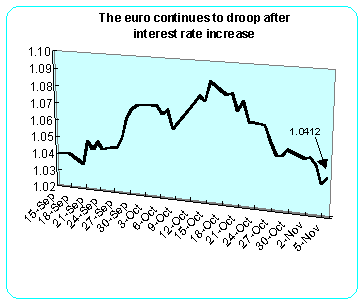
Sterling
The pound sterling continued to slip as market players decided that the Bank of England would not have to raise interest rates as much as previously anticipated. Part of the reason for sterling's decline was the strong asset markets in the United States creating demand for dollars.
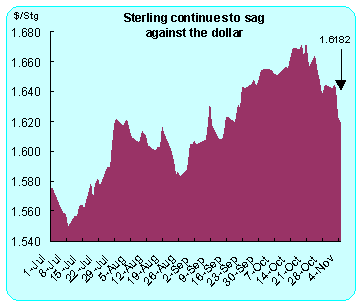
Why U.S. investors care...
By their actions last week, it is clear that the central banks are shifting their focus to growth without inflation from one of preventing disinflation and recession. The surveys released last week reinforce the view that Europe has turned the corner. Although structural reforms especially in the labor markets still need to be addressed, the pressures of competition should help move this political process along. The markets overseas will be watching U.S. markets' reaction to the Microsoft ruling which was handed down on Friday after the markets had closed for the week.
Looking Ahead
|
Central Bank Activities |
| Nov 12 | Japan | Bank of Japan Monetary Policy Committee Meeting |
|
The following indicators will be released this week... |
| Europe | | |
| Nov 8 | EU | Business/Consumer Survey (October) |
| EU | Unemployment (September) |
| UK | Producer Input Prices (October) |
| | Producer Output Prices (October) |
| | Core Output Prices (October) |
| Germany | Industrial and Manufacturing Output (September) |
| Nov 9 | UK | CBI SME Trends Survey (Q3, 1999) |
| | BRC Retail Sales Monitor (October) |
| Germany | Unemployment (October) |
| Nov 10 | France | Current Account Balance (August) |
| | Preliminary Consumer Price Index (October) |
| Germany | Final Consumer Price Index (October) |
| | Trade and Current Account (September) |
| Nov 12 | Germany | Retail Sales (September) |
| Asia | | |
| Nov 8 | Japan | Revised Gross Domestic Product (2Q, 1999) |
| Nov 9 | Japan | Wholesale Prices (September) |
| | Export/Import Prices (October) |
| Nov 11 | Australia | Labor Force (October) |
Release dates are subject to change.
For U.S. data releases, see this week's Simply Economics.
|









